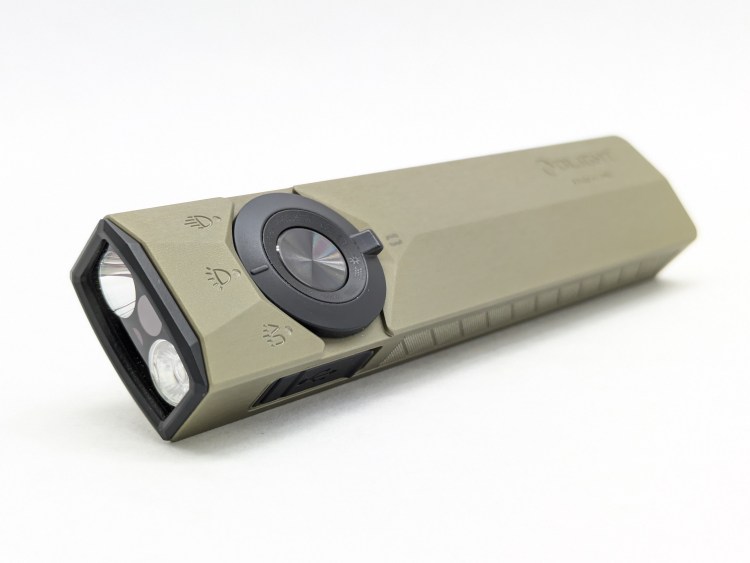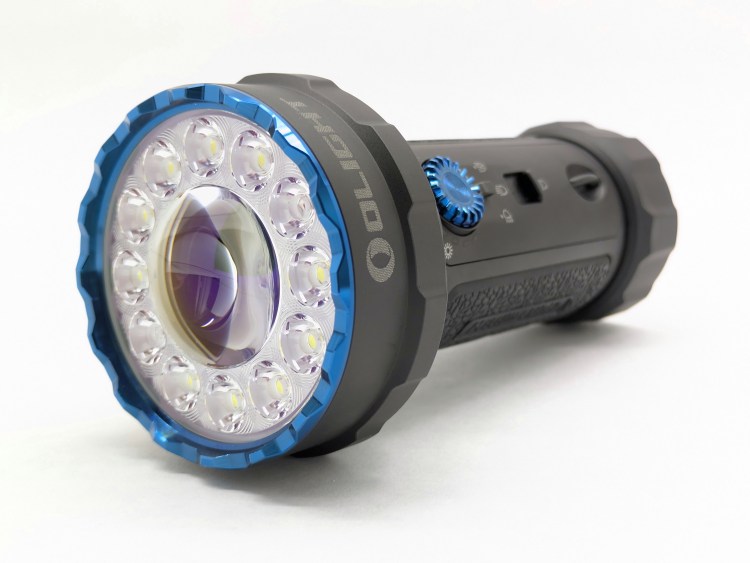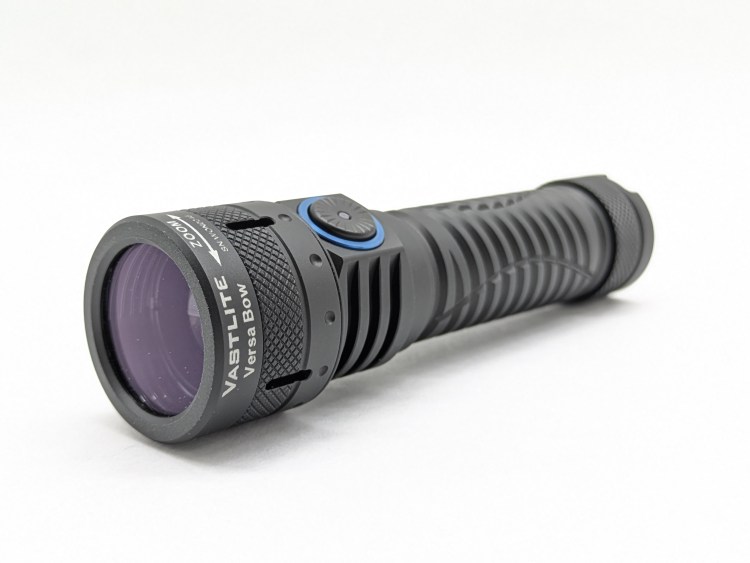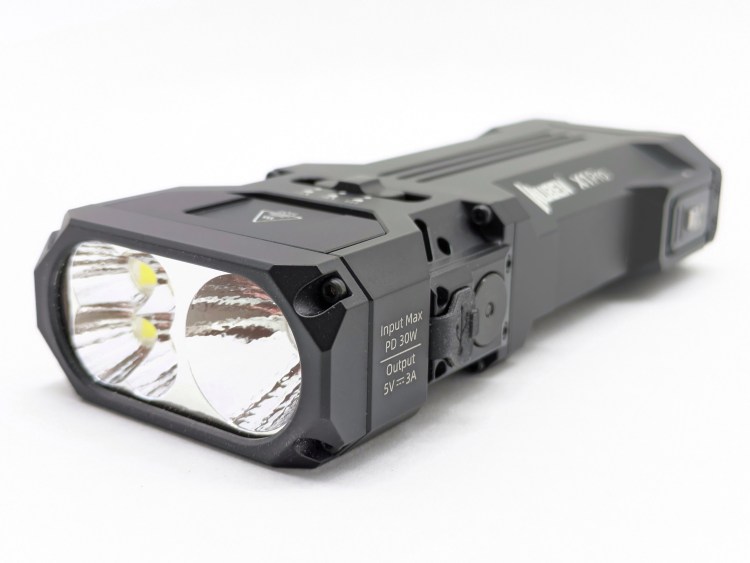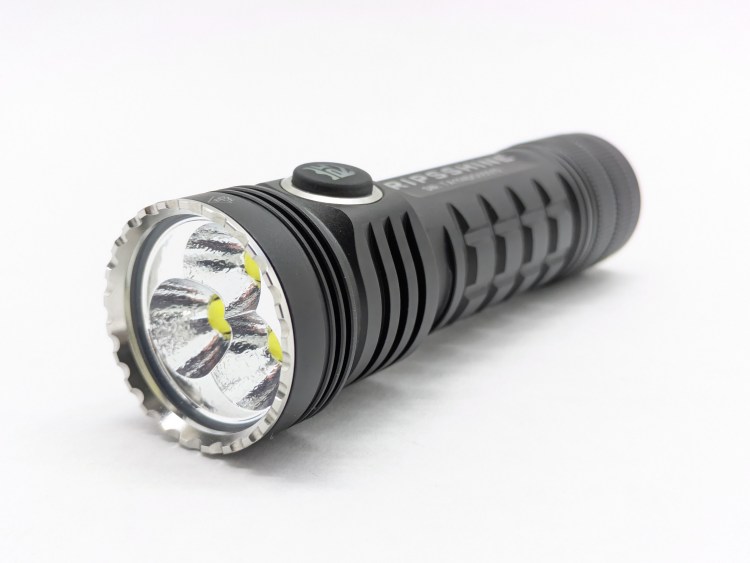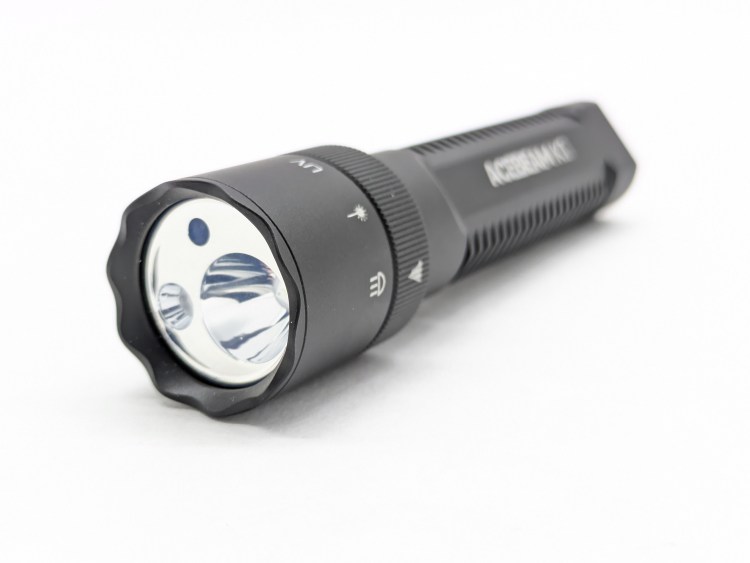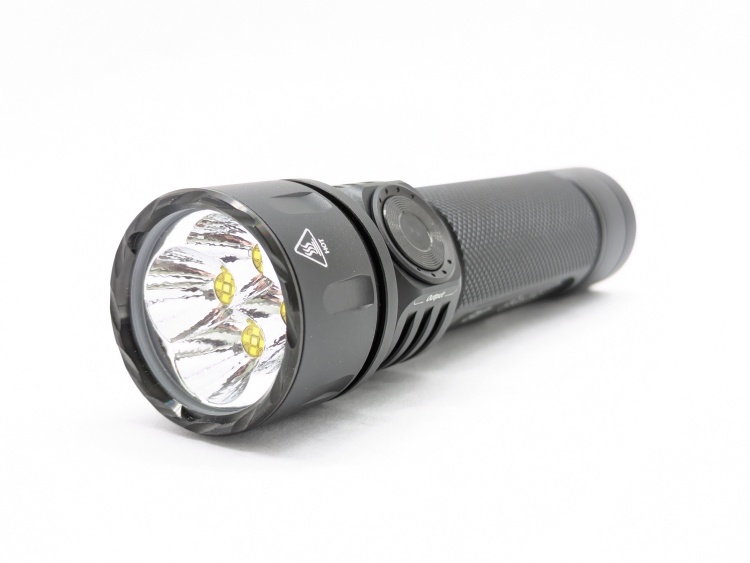Contents
- Pricing & Availability
- What comes in the box?
- Design & Construction
- Size & Measurements
- User Interface
- Emitter & Beam
- Mode Chart
- Runtime
- Driver & Regulation
- Switch
- Carry & Ergonomics
- Batteries & Charging
- Competition
- Conclusion
Pricing & Availability
Skilhunt sent me this light in exchange for an honest review. Here is the official product page where you can see current pricing. I chose the black version with Nichia 519A LEDs. Skilhunt is transitioning over to “ESKTE” as their brand name so you may see ESKTE branding in this review.
What comes in the box?
The box is made of cardstock and is designed for retail with a clear window to see the light inside. The light is held in a thin, vacuum-formed, plastic insert and all the accessories are in another box inside.
- The light itself
- Battery (inside the light)
- Pocket clip
- ZWB2 filter
- User manual
- USB A-to-C charging cable
- Wrist lanyard
A drawstring pouch is also included but is not inside the regular box. You may only get that if you order directly from Skilhunt.
I think a plastic wand diffuser would have been a great inclusion as well. I got one specifically for this light from Spiy3DPrints. It’s particularly fun when using the colored LEDs.

Design & Construction
MiX-7 is a small light with a flared head, similar to some mini throwers. Where mini throwers have a single LED and a large reflector, MiX-7 has seven LEDs each in their own small reflector. The body tube is short with creative milling for grip and there’s a large blue bezel.
I’m not a fan of the blue accents on the bezel and retaining rings. Between that and the magnetic charging, it seems like Skilhunt may be trying to copy Olight and that’s not a good impression. The blue accents look particularly odd with some of the other body colors like orange. I wish they were black, silver, or body-color instead.
The build quality is solid. It’s noticeably better than Convoy, Thrunite, or Sofirn, but not quite on the same level as Acebeam or Olight. The only specific quality gripe I have is that it’s difficult to get the threads started and hard to tell if they’re getting cross-threaded. Mechanical lockout works great. The body tube is glued to the head and I don’t like that.
Size & Measurements
Olight Arkfeld Pro | Skilhunt H300 | Armytek Wizard WR | Skilhunt MiX-7 | Mini Maglite

| Measurement | Measured (mm) |
|---|---|
| Bezel Diameter | 32.5 |
| Maximum Head Diameter | 32.5 |
| Length | 79.4 |
| Switch Diameter | 9.7 |
| Switch Proudness | -0.6 |
| Reflector Diameter | U/M |
| Reflector Height | U/M |
| MCPCB Size | Custom |
| Body Tube Diameter (maximum) | 23.6 |
| Body Tube Diameter (mode) | 22.2 |
| Pocket Clip Slot Width | 4.4 |
| Pocket Clip Slot Diameter | 20.6 |
| Tailcap Diameter | 23.5 |
| Tailcap Length | 12.8 |
| Driver Diameter | U/M |
| Included Battery Length | 39.1 |
| Included Battery Diameter | 18.5 |
Weight with included battery & clip: 89g
User Interface
This light has a lot of different LEDs to control with a single button. The white modes work how you’d expect, but it gets confusing and disorganized when you enter the Moonlight and color modes.
Main modes: 1C turns the light on/off in the main white mode group. 1H while on cycles the brightness level (low-med-high). When you turn the light off and back on again via 1C, it will return to the same main level you used previously.
I like the way this part of the UI works. It’s the same as most other e-switch lights.
Turbo: 2C from anywhere (except moon/colors) activates Turbo. 2C in Turbo will return you to the memorized mode, which is great. 1C from Turbo turns the light off. 1H from Turbo will switch between the two different Turbo levels. The next time you activate Turbo, it’ll return to the Turbo level you last used. I don’t find the dimmer Turbo level useful at all, but it never got in my way.
Blinkies: 3C from anywhere (except moon/colors) activates the last blinky mode you used. That’s the same shortcut that most lights use, so there shouldn’t be a learning curve. 1C will turn it off. 2C will cycle to the next blinky mode. There are four blinky modes: white strobe, red SOS, red beacon, and RGB beacon.
Lockout: 4 clicks from off enters lockout mode and enables theblinking red switch beacon. 2 clicks while in lockout disables/enables the switch beacon. 4 clicks from lockout will exit lockout and put you in the higher of the two Moonlight modes.
Entering lockout mode should not automatically activate the indicator. It should remember whether the user left it on or turned it off previously.
Moonlight/Colors: 1H from off will activate the moonlight or color modes. 1C will turn it off. 1H will cycle to the next color (white, red, green, blue, UV). 2C will cycle the brightness between low and high. For white, “low” and “high” are just two moonlight levels.
In this mode group, 2C changes brightness. That’s different than the rest of the UI where 1H changes brightness. In this mode group, 1H changes the color. That inconsistency trips me up and I frequently find myself trying to toggle from bright Moonlight to dimmer Moonlight but actually blasting my surroundings with 250 red lumens. It’s a bit frustrating.
Color modes should have been grouped behind 2H from off instead of lumped in with the white Moonlight modes. That would provide direct access to your color mode of choice without sacrificing direct access to Moonlight. The 2H from off shortcut isn’t even used for anything else in this UI.
There’s no color mixing despite “MiX” being in the product name. I think that’s a good choice because adding color mixing would make this UI even more complex and confusing.
Emitter & Beam

As its name Suggests, MiX-7 has seven LEDs. Three white LEDs (Nichia 519A 4500K R9080 or Cree XP-G4 CW) three visible color LEDs (Cree XPE-2 Red, Green, and Blue) and one Z5-1B UV LED. I chose the Nichia white LEDs for their nice color properties. All the LEDs sit in a multi-reflector with no intersecting cones, so there shouldn’t be any flower petals in the beam. Curiously, the ZWB2 filter for the UV LED comes separately in the box. You have to unscrew the light’s bezel, drop in the filter, and put it back together.

The white beam is soft and floody with no artifacts at all. It’s delightful up close but it doesn’t reach very far. The visible color beams are a bit narrower. They each have a flat spot on the spill where they’re slightly blocked by the reflector. I didn’t notice the flat spots until I took the above photos ~3 weeks after receiving the light. Very clean beams overall.
In the beamshots below, the basketball goal to the right of the hotspot is 39M away and the power pole in the center is 185M away.














Mode Chart
Disclaimer: All of my measurements are taken at turn-on. Lumen measurements were taken on a Texas Ace 3.5″ Lumen Tube. A candela measurement was taken at 10 meters with an Opple Light Master III on the highest brightness, and other candela figures were calculated relative to that. CRI, CCT, & DUV data were taken for each mode from a few feet away at the center of the hotspot with the Opple Light Master and Waveform DUV Calculator. Runtime tests were performed with the Ceilingbounce app on my smartphone. All of these tests were performed with a fully charged included battery unless otherwise specified. I cannot measure moonlight directly, so moonlight readings are calculated based on the brightness relative to the next-lowest mode. None of this is professional equipment, so take all of these measurements with a grain of salt.

Above are the official specs, followed by my own measurements below.
| Level | Lumens | Candela | Throw (Meters) | CRI (Ra) | Color Temp. (K) | DUV (Tint) |
| Turbo (T1) | 1560 | 3700 | 122 | 97 | 4470 | -0.0012 |
| T2 | 760 | 1803 | 85 | 98 | 4430 | 0.0000 |
| High (H1) | 400 | 949 | 62 | 98 | 4360 | -0.0004 |
| Medium (M1) | 130 | 308 | 35 | 98 | 4360 | 0.0008 |
| Low (M2) | 35 | 83 | 18 | 98 | 4350 | 0.0009 |
| L1 | 3 | 7 | 5 | 98 | 4340 | 0.0010 |
| Moonlight (L2) | 0.6 | 1.4 | 2.4 | 98 | 4350 | 0.0009 |
| Level | Lumens / % |
| Red High | 270 |
| Red Low | 28 |
| Green High | 250 |
| Green Low | 46 |
| Blue High | 140 |
| Blue Low | 17 |
| UV High | 100% |
| UV Low | 17% |
Runtime


White Performance: For a small light with high CRI LEDs, it’s expected that Turbo doesn’t last very long. That tells me it’s being pushed hard like I want. Sustained brightness is an impressive 400 lumens. I’ve reviewed larger lights with lower sustained output than that. Total runtime is pretty short due to the small battery.
Color Performance: None of the colors get bright enough to need thermal regulation so most of them can stay at max brightness until the battery is empty. They all last at least an hour. UV lasts longer but also starts to slowly decrease in brightness as the battery drains. I don’t have a lot to compare with, but I’m totally satisfied with this color performance.
Thermal regulation is a timed step-down from Turbo only. There is no active thermal regulation. That means the light will perform very consistently but may also overheat in hot weather or leave some performance on the table in cold weather.
LVP (Low Voltage Protection) is present and the light will shut itself off when the battery gets low. It should be safe to use unprotected batteries.
Driver & Regulation

Skilhunt tends to use Buck or Boost drivers that provide good efficiency and regulation. In this case, I believe it’s a Buck driver but I haven’t been able to confirm that. The body tube is glued to the head so I wasn’t able to access the driver or get any detailed photos.


Regulation for the white channel is about what I expected. Turbo is affected by battery voltage, but brightness is still respectable even with a very low battery. Other white modes are unaffected.
Color regulation is better than I expected. All the visible colors are unaffected by battery voltage. Even UV is relatively well-regulated. That’s highly unusual and an excellent surprise because UV LEDs are notoriously difficult to drive.
Note: All regulation measurements are taken at turn-on so they do not reflect any thermal or low voltage stepdowns that may occur. A value of 0 indicates low voltage shutoff immediately upon activation.
PWM: No PWM is visible to my eyes or camera, nor audible to my ears on the white modes.
Parasitic Drain: 60 microamps when off or in lockout with the beacon disabled. That will take ~2 years to drain the included battery. In lockout with the switch beacon on, it oscillates between ~170 and ~1500 microamps. That will drain the battery in less than 2 months. I recommend loosening the tailcap instead of using the electronic lockout.
Switch
MiX-7 is controlled by an electronic side switch. It sits slightly recessed inside a blue retaining ring and has a backlight in the center. It’s nicely audible and tactile, but it takes very little force to actuate. That low actuation force made me concerned that it might easily turn on by accident, but that hasn’t happened to me while carrying MiX-7. I would have preferred a firmer switch that required more force to actuate.
The backlight glows to indicate battery status for a few seconds after the light is turned on. Constant blue means >80% power remaining. Blinking blue means 50-80%. Constant red means 20-50%. Blinking red means <20% remaining. This indicator system works if you’re familiar with it, but it’s not intuitive. It takes some practice and memorizing what the colors and blinks mean. I prefer indicators with four separate LEDs that each indicate 25%. That’s intuitive and glanceable.
Carry & Ergonomics
Ergonomics: This is a small light so it’s a little fiddly. The ergonomics are OK. I find a pencil grip more comfortable than a forward grip on this model. When I use a forward grip, it feels too short. It would have been nice to have an 18650 body tube option to make it longer. Adding the pocket clip helps it feel more secure in the hand and it also helps differentiate between the switch and the charging port.
Clip: I don’t love this clip solution but it works. The clip itself is pretty great. It carries deep and there’s plenty of ramp at the front to get it over pants material. It’s bidirectional too so you can clip it to a hat. The clip slot size is fairly common so you should be able to fit other clips if this one doesn’t suit your needs.
My only major gripe is that the clip is that the clip covers up the charging port. If I move it away from the charging port, then it’s no longer opposite the button how I like. If I move it out of the way when I need to charge, then it will eventually wear away the anodizing under the clip arms. Overall I would have preferred a shorter, single-direction clip that doesn’t interfere with charging. Alternatively, an 18650 body tube option would also solve this problem.
Magnet: There’s a strong magnet inside the tailcap. It’s strong enough to hold the light up on a vertical surface even with a big diffuser wand attached. If you don’t like the magnet, you can remove it, and Skilhunt includes a magnet-shaped black rubber spacer in the box to fill the spot inside the tailcap. There’s also a weaker magnet in the charging contacts that cannot be removed.
Batteries & Charging

Battery: MiX-7 uses a single 18350 battery and a Skilhunt BL-111 battery is included. It’s a protected, button top, 1100mah, 8A discharge cell that’s well suited to this light. Unprotected flat top cells should fit and work just fine. 16340 cells should work fine as well, though they may rattle a bit. CR123As will work in a pinch but the light will shut off prematurely because they have a different voltage than the lithium-ion batteries it’s designed to use. I don’t think batteries with a USB port in will fit due to length. It would have been nice to have an optional 18650 battery tube for longer life and better ergonomics.
Charging is facilitated by the included magnetic puck USB charging cable. The magnet end snaps onto the contacts on the head of the light for easy charging. The magnetic connection is pretty weak and finicky though. A slight jostle can cause it to lose connection so it’s not as robust as competing magnetic charging systems from Olight and Armytek.
The light is fully functional while charging if the battery is connected. It still works without the battery but may not get quite as bright. Since the contacts are exposed, this may be a poor choice if you work around ferrous metal shavings. It’s unlikely that the contacts could be shorted, but it is possible.
Competition
Here are some lights in the same class and how they compare.
- Same price
- White+RGB (no UV)
- Extremely similar UI
- Longer, larger diameter body, smaller diameter head
- Much larger 21700 battery
- USB-C charging instead of magnetic
- No magnetic tailcap
- Quad TIR optic instead of reflector
- More expensive
- White+UV+Laser (no RGB)
- Thin, flat shape
- Better magnetic charging
- Build in battery
- Better UI with an excellent rotary toggle switch
- similar price, shape, and size
- White + UV only, no RGB
- No high CRI LED options and no ZWB2 filter for the UV
- marginally better pocket clip
- better magnetic charging implementation
- requires proprietary battery
Here’s a list of all the flashlights with white, UV, and RGB LEDs.
This section is not comprehensive. If I didn’t include a particular light here, it doesn’t mean it’s bad or doesn’t deserve to be here. I simply cannot list every possible competitor.
Conclusion
This is a fun little light and I like it quite a bit. I’ve wanted good red, green, blue, and UV lights for a while but I didn’t want to buy four separate lights to carry around with four separate batteries to manage. This one light will suit all my colored-LED needs in a small, portable package. Plus, it’s got useful, high-CRI white light too! I hope Skilhunt releases an updated version in the future with no blue accents, a revamped UI, and a shorter clip or optional 18650 body tube.
Thanks to Skilhunt for sending me this light for review!






























